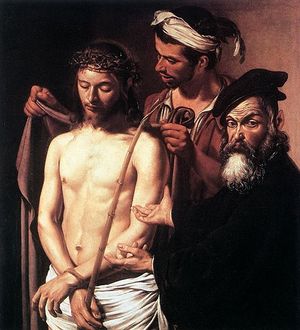Lodovico Carracci: Difference between revisions
No edit summary |
No edit summary |
||
| (2 intermediate revisions by the same user not shown) | |||
| Line 1: | Line 1: | ||
{{Header|Lodovico Carracci}} | {{Header|Lodovico Carracci}} | ||
[[Image:CaravaggioEcceHomo.jpg|thumb|Right|{{bc|"Ecce Homo"}}]] | [[Image:CaravaggioEcceHomo.jpg|thumb|Right|{{bc|"Ecce Homo"}}]] | ||
'''Lodovico Carracci''' ( | '''Ludovico''' (or Lodovico) '''Carracci''' ({{star}}21 April 1555 – {{dag}}13 November 1619) was an Italian, early-Baroque [[painter]], [[etcher]], and [[printmaker]] born in Bologna. His works are characterized by a strong mood invoked by broad gestures and flickering light that create spiritual emotion and are credited with reinvigorating Italian art, especially fresco art, which was subsumed with formalistic Mannerism. He died in Bologna in 1619. | ||
==Biography== | |||
Ludovico apprenticed under Prospero Fontana in Bologna and traveled to Florence, Parma, and Venice, before returning to his hometown. Together with his cousins [[Annibale Carracci|Annibale]] and [[Agostino Carracci]], Ludovico worked in Bologna on the fresco cycles depicting Histories of Jason and Medea (1584) in Palazzo Fava, and the Histories of Romulus and Remus (1590-1592) for the Palazzo Magnani. Their individual contributions to these works are unclear, although Annibale, the younger than Ludovico by 5 years had gained fame as the best of the three. This led to Annibale's famed commission of the Loves of the Gods in the Palazzo Farnese in Rome. Agostino joined Annibale there briefly. | |||
While Ludovico remained in Bologna, this does not mean that he was any less influential, the biography of Lanzi states that around 1585, Ludovico and his cousins had founded the so-called Eclectic Academy of painting (also called the Accademia degli Incamminati. More recent conjectures are that there was no established Academy with curriculum, but that Ludovico tutored many in his studio. | |||
This studio however propelled a number of Emilian artists to pre-eminence in Rome and elsewhere, and singularly helped encourage the so-called Bolognese School of the late [[16th century]], which included Albani, Guercino, Sacchi, Reni, Lanfranco and Domenichino. The Carracci had their apprentices draw studies focused on observation of nature and natural poses, and use a bold scale in drawing figures. Two of Ludovico's main pupils were Giacomo Cavedone and Francesco Camullo. | |||
{{Carracci}} | {{Carracci}} | ||
{{ | {{footer}} | ||
Latest revision as of 08:43, 14 April 2022
Ludovico (or Lodovico) Carracci (✦21 April 1555 – †13 November 1619) was an Italian, early-Baroque painter, etcher, and printmaker born in Bologna. His works are characterized by a strong mood invoked by broad gestures and flickering light that create spiritual emotion and are credited with reinvigorating Italian art, especially fresco art, which was subsumed with formalistic Mannerism. He died in Bologna in 1619.
Biography
Ludovico apprenticed under Prospero Fontana in Bologna and traveled to Florence, Parma, and Venice, before returning to his hometown. Together with his cousins Annibale and Agostino Carracci, Ludovico worked in Bologna on the fresco cycles depicting Histories of Jason and Medea (1584) in Palazzo Fava, and the Histories of Romulus and Remus (1590-1592) for the Palazzo Magnani. Their individual contributions to these works are unclear, although Annibale, the younger than Ludovico by 5 years had gained fame as the best of the three. This led to Annibale's famed commission of the Loves of the Gods in the Palazzo Farnese in Rome. Agostino joined Annibale there briefly.
While Ludovico remained in Bologna, this does not mean that he was any less influential, the biography of Lanzi states that around 1585, Ludovico and his cousins had founded the so-called Eclectic Academy of painting (also called the Accademia degli Incamminati. More recent conjectures are that there was no established Academy with curriculum, but that Ludovico tutored many in his studio.
This studio however propelled a number of Emilian artists to pre-eminence in Rome and elsewhere, and singularly helped encourage the so-called Bolognese School of the late 16th century, which included Albani, Guercino, Sacchi, Reni, Lanfranco and Domenichino. The Carracci had their apprentices draw studies focused on observation of nature and natural poses, and use a bold scale in drawing figures. Two of Ludovico's main pupils were Giacomo Cavedone and Francesco Camullo.
Chat rooms • What links here • Copyright info • Contact information • Category:Root
